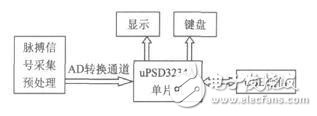This paper presents a design scheme of a reflective infrared heart rate detector based on uPSD3234. The program uses the single-chip uPSD3234 as the core component of the system, and uses the digital signal processing method such as matching filtering to obtain the heart rate data. The microelectronic technology and the biomedical engineering technology are closely combined to meet the requirements of the scheme design and realize the heart rate of the human body. measuring.
The pulse wave originates from the heart beat and travels from the heart to the peripheral artery. Its comprehensive information on morphology, intensity, rate and rhythm largely reflects the blood characteristics of many physiological and pathological processes in the human cardiovascular system. Heart rate is an important physiological indicator. It refers to the number of heart beats per unit time and is a physiological indicator for clinical routine diagnosis.
In order to measure heart rate signals, there are many techniques that can be applied, such as blood measurement, heart sound measurement, ECG measurement, and the like. In this paper, we use the high opacity of blood and the great difference between tissue and blood translucency. The pulse signal is obtained by photoelectric pulse sensor. After analog-to-digital conversion (A/D), the sampled data is digitally analyzed and processed to achieve Measurement of the human heart rate.
1 heart rate detector system structure and working principle
The main components of the heart rate tester are shown in Figure 1. The pulse signal is collected by the photoelectric sensor, and the data of the pulse signal is sampled by the A/D conversion module provided by the preamplifier, filtering, and the single chip of the uPSD3234A, and stored in the memory; the single chip performs digital signal processing on the obtained data and calculates the heart rate value. The result is sent to the display module and memory.

Figure 1 digital heart rate detector block diagram
1.1 heart rate signal acquisition preprocessing circuit
The pulse signal acquisition preprocessing circuit mainly converts the pulse wave into an electrical signal and performs preliminary high frequency filtering preprocessing. The key part is the photoelectric pulse sensor. Photoelectric pulse sensors can be divided into transmissive and reflective according to the way of receiving light.
Reflective not only can accurately measure the change of blood vessel volume, but in practical applications, the reflection only needs to touch the sensor to any part of the body. When the blood flow of the irradiated part changes with the heartbeat, the infrared receiving probe receives the heart. The arterial pulse pulse signal is periodically contracted and dilated, thereby acquiring a heart beat signal.
This design uses a reflective infrared sensor. As shown in Fig. 2, the photoelectric pulse sensor adopts infrared pair tubes KP-2012F3C and KP-2012P3C, and is arranged in reflection. KP-2012F3C has good skin illumination, the current is generally set at 20mA, and the brightness is controlled by software through PWM current, which can make the infrared LED work in the saturated region and emit light with stable light intensity.

Figure 2 pulse signal acquisition preprocessing circuit
The KP-2012P3C transistor uses an AC-coupled structure to enhance amplification of weak signals. The signal detected by the transistor is divided into two paths when sampling. All the way is the DC signal line. It is the transistor output and the A/D conversion channel port 0 of the input MCU, which can be used to detect whether the transistor is in the active working state; the other is the AC signal line. It is input to the two-stage filter forming circuit through an emitter follower and then input to the A/D conversion channel of the single chip. 1. The filter circuit is a two-stage band pass filter circuit, because the spectrum of the pulse wave contains rich pathological information, especially The spectrum in the interval of 5~40Hz carries a lot of information related to coronary heart disease, so considering the expansion of the function in the future, the upper and lower limits of the preprocessing circuit are designed to be 48Hz and 0.86Hz.
Big Suction Robotic Vacuum Cleaner
Big Suction Robotic Vacuum Cleaner,Robotic Vacuum Cleaner,Carpet Cyclone Vacuum Cleaner,Water Filtration Vacuum Cleaner Robot
NingBo CaiNiao Intelligent Technology Co., LTD , https://www.intelligentnewbot.com
